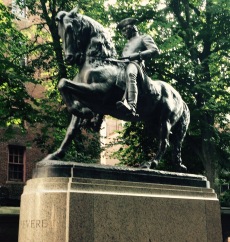I love music, all kinds of music, though my family thinks I’m stuck on Hard Rock. I usually have music playing while I’m working or researching. Today I thought I would go to the Internet Archive [archive.org], which is a website with “TONS” of free content and listen to a concert while I worked. I was surprised to see that the website has a new, updated look and has been revamped to make it easier to locate content.
This archive is an incredible resource for genealogists. It is a non-profit, free use library with millions of free books, movies, software, music and much more. Sections include Images from all over the world including collections of USGS maps, early maps of many countries, pictures from museums, and from NASA including NASA eClips, and much more. Videos include Concerts, old Classic TV Shows, Vintage Cartoons, Silent Films and of course many more. Music can be downloaded and has many genres from Grateful Dead, to and including music from the 30’s and 40″s, ie. Kate Smith. Concerts have content back to 1958.. Software allows you to locate and download software from their Open Source Collection .
Open Library has books from all over the world. The ebook section has over 250,000 titles and allows you to borrow [free] ebooks for 2 weeks, up to 5 titles at a time. They come either in-browser, PDF or ePub. Open Library also will link you to World Cat [the World Library Catalog] to help you find books that you can borrow through inter-library loan.
The Text area is my favorite and includes a Microfilm Collection, the Project Gutenberg [free plain text versions of free books], and Digital Collections from many libraries including The Allen County Library. Today I downloaded an early book about the Bliss Family, visited the digital content of the National Library of Scotland, went to the American Libraries and downloaded a book of clarinet etudes in PDF, a book from the Wellesley College Library called ‘Sketches of the British Reformers,” and I also borrowed 2 eBooks, Between Open Library and Internet archive you have access to over 8 million public domain eBooks.
I did all this while listening to a piano pice from the early 1900’s, some cylinder recordings [before mp3 there were vinyl records, and before records there were cylinders.] A free sign-in is available which allows you to save your favorites findings and also share them with your friends.
 e opportunity to spend this past 4th of July week in Boston. For someone who has 24 [possibly 25] ancestors who served the Revolutionary cause, and who loves history – it was an exciting time. I don’t know the detailed stories, yet, of each ancestor who served, however, the ones I am familiar with make me very proud of the sacrifices they made for this country. I have one ancestor Wait Hopkins who was killed in the war, and another Richard Lyman who died relatively young because of the hardships he faced during the war.
e opportunity to spend this past 4th of July week in Boston. For someone who has 24 [possibly 25] ancestors who served the Revolutionary cause, and who loves history – it was an exciting time. I don’t know the detailed stories, yet, of each ancestor who served, however, the ones I am familiar with make me very proud of the sacrifices they made for this country. I have one ancestor Wait Hopkins who was killed in the war, and another Richard Lyman who died relatively young because of the hardships he faced during the war.